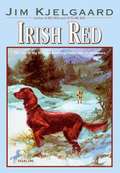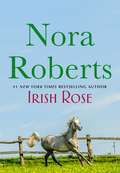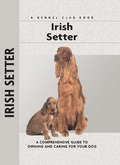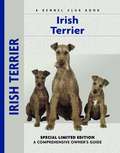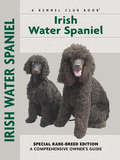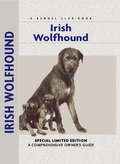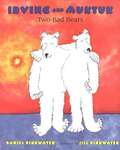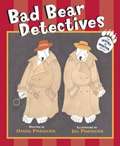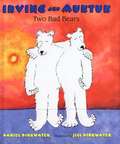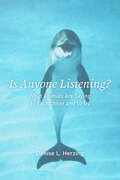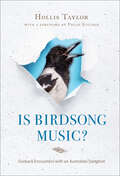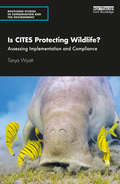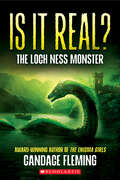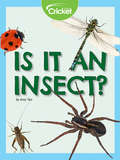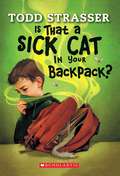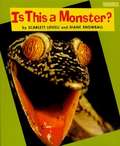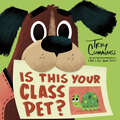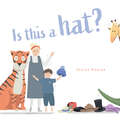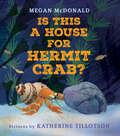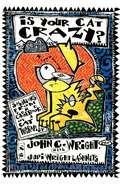- Table View
- List View
Irish Red: Son of Big Red (Famous Dog Stories)
by Jim KjelgaardIrish Red: Son of Big Red A TALE OF A TRUE CHAMPION This is the unforgettable story of a boy and his dog and the wilderness trek that sealed their friendship. It is the heartwarming story of Mike, the rebel who found his master. And of Danny, who learned that a dog, like a man, needs time to grow into his own. Together they faced a killing snowstorm and a murderous puma. Together they won a special victory which would forever establish the place of the Irish Red in the wild Wintapi.
Irish Rose: Irish Thoroughbred; Irish Rose (Irish Hearts Ser. #2)
by Nora RobertsA young woman accepts a job offer that promises to bring her a lifetime of love as the Irish Hearts Trilogy continues in #1 New York Times bestselling author Nora Roberts’ Irish Rose.Burke Logan came to Ireland looking for thoroughbreds for his Maryland horse farm—but never expected Erin McKinnon to catch his eye. Unable to get the fiery beauty out of his mind, Burke offers her a bookkeeping position back home. Despite his audacity, Erin jumps at the chance to leave her small-town life in Skibbereen behind for the endless opportunities America offers, and for more attention from her handsome employer. Once stateside, their initial attraction grows undeniably stronger, but Burke is keeping Erin at arm’s length—to protect her from a secret in his past that could destroy their love.
Irish Setter (Comprehensive Owner's Guide)
by Margaret WilliamsWith his regal carriage and his hallmark chestnut red color, the Irish Setter is built like an elegant thoroughbred horse.<P><P> A longtime favorite of pet owners, field enthusiasts, and dog-show aficionados, the Irish Setter is as talented as he is devoted. He owes his reputation as a winning show dog to his natural elegance and beauty, just as his prowess in the field position him as a top contender at hunting events. As a companion dog, the Irish Setter is bursting with Irish charm, possessing a jovial, friendly nature that owners find irresistible. This Comprehensive Owner's Guide begins with a concise history of the breed's development in Ireland, England, and the United States, followed by a chapter on the breed's characteristics. The author, Margaret Williams, extols the breed's attributes as an appealing family companion and recommends that owners undertake the training of the young puppy with great care, given the breed's high-energy approach to life.New owners will welcome the well-prepared chapter on finding a reputable breeder and selecting a healthy, sound puppy. Chapters on puppy-proofing the home and yard, purchasing the right supplies for the puppy as well as house-training, feeding, and grooming are illustrated with photographs of handsome adults and puppies. In all, there are over 135 full-color photographs in this useful and reliable volume. The author's advice on obedience training will help the reader better mold and train into the most well-mannered dog in the neighborhood. The extensive and lavishly illustrated chapter on healthcare provides up-to-date detailed information on selecting a qualified veterinarian, vaccinations, preventing and dealing with parasites, infectious diseases, and more. Sidebars throughout the text offer helpful hints, covering topics as diverse as historical dogs, breeders, or kennels, toxic plants, first aid, crate training, carsickness, fussy eaters, and parasite control. Fully indexed.
Irish Terrier
by Bardi MclennanTerrier-breed expert Bardi McLennan unveils the mystery of the Irish Terrier, whose "heedless, reckless pluck" has made him the indisputable "daredevil" of the dog world. Fiery, protective, friendly, and affectionate, the Irish Terrier possesses an intense personality that is only exceeded by his loyalty to his owner and family. In the history chapter that opens this Comprehensive Owner's Guide, McLennan retells the origins of the terriers of the Emerald Isle, how various terrier types evolved, and how the Irish Terrier-as a purebred dog-came to fame and favor among farmers, dog breeders, military personnel, and peasants, especially as a children's companion. In the chapter on the breed's characteristics, the author offers sound advice for all potential owners of the Irish Terrier. Recognizing the breed's bold and boisterous nature, the Irish Terrier "is not a breed for the timid, the weak-willed or those who merely wish to pamper a pet and be pampered in return." Today's Irish Terriers, though not as "reckless" as his forebears, "should not be thought of anything more than assertive. He is not aggressive toward people, but he is a dog who likes who he is and doesn't mind letting others know it."New owners will welcome the well-prepared chapter on finding a reputable breeder and selecting a healthy, sound puppy. Chapters on puppy-proofing the home and yard, purchasing the right supplies for the puppy as well as house-training, feeding, and grooming are illustrated with photographs of handsome adults and puppies. In all, there are over 135 full-color photographs in this useful and reliable volume. The author's advice on obedience training will help the reader better mold and train into the most well-mannered dog in the neighborhood. The extensive and lavishly illustrated chapter on healthcare provides up-to-date detailed information on selecting a qualified veterinarian, vaccinations, preventing and dealing with parasites, infectious diseases, and more. Sidebars throughout the text offer helpful hints, covering topics as diverse as historical dogs, breeders, or kennels, toxic plants, first aid, crate training, carsickness, fussy eaters, and parasite control. Fully indexed.
Irish Water Spaniel
by Marion HopkinsThe Irish Water Spaniel's curly liver locks and distinctive topknot have won the breed admirers on both sides of the pond, not the least of whom is author and longtime breeder Marion Hopkins, regarded as the IWS authority in America. Regarded as a superb family companion and an enduring and proficient field worker, the Irish Water Spaniel is a hardy, resilient retriever and an obedient and biddable companion that enjoys athletic activities with his owner-on land and water. Written with wit, wisdom, and no small heaping of common sense, this Comprehensive Owner's Guide details the breed's history in its homeland as well as in England and the United States. The text is illustrated by beautiful color photographs by IWS breeder and photographer Tara Darling, making this book as attractive as it is authoritative. A true fan of this charming Irish breed, the author shares her many years of experience with IWSs in her insightful chapter about the breed's characteristics. As evidenced in the Hopkins's special stories and Darling's photographs, the IWS is a true canine clown, blessed with a real Irish sense of humor, that endears himself to all those who win a place in his inner circle.New owners will welcome the well-prepared chapter on finding a reputable breeder and selecting a healthy, sound puppy. Chapters on puppy-proofing the home and yard, purchasing the right supplies for the puppy as well as house-training, feeding, and grooming are illustrated with photographs of handsome adults and puppies. In all, there are over 135 full-color photographs in this useful and reliable volume. The author's advice on obedience training will help the reader better mold and train into the most well-mannered dog in the neighborhood. The extensive and lavishly illustrated chapter on healthcare provides up-to-date detailed information on selecting a qualified veterinarian, vaccinations, preventing and dealing with parasites, infectious diseases, and more. Sidebars throughout the text offer helpful hints, covering topics as diverse as historical dogs, breeders, or kennels, toxic plants, first aid, crate training, carsickness, fussy eaters, and parasite control. Fully indexed.
Irish Wolfhound
by Alice Kane Cheryl A. ErteltThe tallest dog in the world, the Irish Wolfhound is the true "gentle giant" of the dog world, clad in its characteristic rough coat and standing no less than 31 inches at the shoulder. The breed's devotion to its family, coupled with its bravery and courage, are the stuff of legends, many of which are retold in this Comprehensive Owner's Guide. In the chapter on the breed's history, author Alice Kane explores the Irish Wolfhound's fascinating origins in Ireland and beyond; she is joined by breed expert Gretchen Bernardi, who has provided an excellent and concise history of the Wolfhound in the United States. As Kane discusses in the chapter on the breed's characteristics, the Irish Wolfhound is among the friendliest of all dogs, though he requires a special owner who is able to give him the training, care, and accommodations he needs. As a companion for an active family with children, a more reliable and kinder dog cannot be found.New owners will welcome the well-prepared chapter on finding a reputable breeder and selecting a healthy, sound puppy. Chapters on puppy-proofing the home and yard, purchasing the right supplies for the puppy as well as house-training, feeding, and grooming are illustrated with photographs of handsome adults and puppies. In all, there are over 135 full-color photographs in this useful and reliable volume. The author's advice on obedience training will help the reader better mold and train into the most well-mannered dog in the neighborhood. The extensive and lavishly illustrated chapter on healthcare provides up-to-date detailed information on selecting a qualified veterinarian, vaccinations, preventing and dealing with parasites, infectious diseases, and more. Sidebars throughout the text offer helpful hints, covering topics as diverse as historical dogs, breeders, or kennels, toxic plants, first aid, crate training, carsickness, fussy eaters, and parasite control. Fully indexed.
Irma and Jerry
by George SeldenThe adventures of a cat and a dog living in New York City's Greenwich Village.
Irving and Muktuk
by Daniel PinkwaterEvery year the little town of Yellowtooth celebrates the New Year with a Blueberry MuVin Festival. The festival is fun for all until the year Irving and Muktuk, muVin stealers of the worst kind, show up to crash the party. The bad bears are foiled by OVicer Bunny, but they show up again the next year, and the next, and the next. How will OVicer Bunny keep the bears away for good?
Irving and Muktuk: Bad Bear Detectives
by Daniel M. Pinkwater Jill PinkwaterWhen a shipment of imported Italian muffins goes missing, Irving and Muktuk become the key suspects. Everyone knows their weakness for muffins and immediately think they are responsible! Irving and Muktuk realize that in order to clear their smirched names, they have to find the culprit themselves. They disguise themselves, sniff out some clues, interview possible witnesses, and try to find the thief. As with all good mysteries, the clues lead to a surprise ending.
Irving and Muktuk: Two Bad Bears
by Daniel PinkwaterEvery year the little town of Yellowtooth celebrates the New Year with a Blueberry Muffin Festival. But every year, the festivities come under a shadow cast by Irving and Muktuk, two polar bears whose badness is equaled only by their thick-headedness. These bears are muffin-pilferers of the worst kind. Therefore, they have to contend with Officer Bunny, who is the law in Yellowtooth. Officer Bunny is wise in the ways of the North, and knows how to protect a muffin. As the years go by, Irving and Muktuks muffin-getting schemes turn more and more devious, keeping Officer Bunny on his toes as he tries to figure out what to do with the crafty though dimwitted bears once and for all.
Is Anyone Listening?: What Animals Are Saying to Each Other and to Us
by Denise L. HerzingFrom a leading researcher on dolphin communication, a deep dive into the many ways animal species communicate with their kin, their neighboring species, and us. If you could pose one question to a dolphin, what would it be? And what might a dolphin ask you? For forty years, researcher and author Denise L. Herzing has investigated these and related questions of marine mammal communication. With the assistance of a friendly community of Atlantic spotted dolphins in the Bahamas, Herzing studies two-way communication between different dolphin species and between humans and dolphins using a variety of cutting-edge experiments. But the dolphins are not the only ones talking, and in this wide-ranging and accessible book, Herzing explores the astonishing realities of interspecies communication, a skill that humans currently lack. Is Anyone Listening? connects research on dolphin communication to findings from Jane Goodall on chimpanzees, Dian Fossey on mountain gorillas, Cynthia Moss on African elephants, and others driving today’s exploration of possible animal languages. Although humans have long attempted to crack animal communication codes, only now do we have the advanced machine-learning tools to help. As Herzing reveals, researchers are finding fascinating hints of language in nonhuman species, including linguistic structures, vowel equivalents, and complex repeated sequences. By looking at the many ways animals use and manipulate signals, we see that we’ve only just begun to appreciate the diversity of animal intelligence and the complicated and subtle aspects of animal communication. Considering dolphins and other nonhuman animals as colleagues instead of research subjects, Herzing asks us to meet animals as both speakers and listeners, as mutually curious beings, and to listen to what they are saying.
Is Birdsong Music?: Outback Encounters with an Australian Songbird (Music, Nature, Place)
by Philip Kitcher Hollis TaylorHow and when does music become possible? Is it a matter of biology, or culture, or an interaction between the two? Revolutionizing the way we think about the core values of music and human exceptionalism, Hollis Taylor takes us on an outback road trip to meet the Australian pied butcherbird. Recognized for their distinct timbre, calls, and songs, both sexes of this songbird sing in duos, trios, and even larger choirs, transforming their flute-like songs annually. While birdsong has long inspired artists, writers, musicians, and philosophers, and enthralled listeners from all walks of life, researchers from the sciences have dominated its study. As a field musicologist, Taylor spends months each year in the Australian outback recording the songs of the pied butcherbird and chronicling their musical activities. She argues persuasively in these pages that their inventiveness in song surpasses biological necessity, compelling us to question the foundations of music and confront the remarkably entangled relationship between human and animal worlds. Equal parts nature essay, memoir, and scholarship, Is Birdsong Music? offers vivid portraits of the extreme locations where these avian choristers are found, quirky stories from the field, and an in-depth exploration of the vocalizations of the pied butcherbird.
Is CITES Protecting Wildlife?: Assessing Implementation and Compliance (Routledge Studies in Conservation and the Environment)
by Tanya WyattThis book assesses the Convention on International Trade in Endangered Species of Wild Fauna and Flora (CITES), examining both implementation and compliance. Humans are causing a biodiversity crisis, where 1 million species are facing extinction. Species are dying, in no small part, because they are overexploited, poached and trafficked and CITES is the main international instrument designed to protect traded wildlife. Does the state of the world’s species mean CITES is failing? This book explores the implementation of and compliance with CITES by all 183 member countries. It is imperative we know the nature and extent of the implementation of and compliance with CITES legislation in all parties to fully understand the impact of legal and illegal trade on species survival. Through extensive legislative content analysis, a Delphi iterative survey, and semi-structured interviews, this is the first book to share empirical research about CITES implementation and compliance. This book contains a comprehensive analysis of the state of CITES, what is done well, what could be done better, and what the future might bring to try to curtail the slide of the world’s wildlife into extinction. By identifying lessons learned in relation to CITES legislation, implementation and compliance this book provides hard evidence to member countries as to how their own practice can be improved. This timely book will be essential reading for students and academics interested in wildlife law, trade and trafficking, green criminology and biodiversity conservation more broadly. It will also be of interest to professionals working in wildlife law enforcement.
Is It Real? The Loch Ness Monster
by Candace FlemingPut on your detective hat and prepare all your investigative tools, because you've been assigned a new case to solve: the mystery of the Loch Ness Monster!Follow along as award-winning author Candace Fleming uses all of her nonfiction tools and storytelling prowess to investigate the enduring mystery surrounding the existence of the Loch Ness Monster.Nestled in the lush green hills of the Scotland Highlands lies Loch Ness, a deep, murky lake with a storied history. It is also the home of the Loch Ness Monster. Numerous stories and photographs by people claiming to have spotted the mysterious monster have surfaced, often gaining immediate fame. But after decades of countless expeditions, documentaries, firsthand accounts, pictures, and videos, the mystery of Nessie continues to haunt us.Now, Sibert Award-winning author Candace Fleming invites you to become a detective and to join the race to uncover the truth. You'll learn how real-life detectives and scientists conduct their investigations to solve the greatest mysteries as the principles of the Scientific Method and more tools for boosting critical thinking and analysis are introduced. You will consider the evidence, see if you can tell the difference between fact and fiction, and maybe you can answer this age-old question about the Loch Ness monster: Is it real?
Is It an Insect?
by Amy TaoDo you know how to tell if a creepy-crawly is an insect? Is a spider an insect? What about a millipede? Read on to learn how and put your skills to the test!
Is That a Dead Dog in Your Locker?
by Todd StrasserThe Tardy Boys, Wade and Leyton, are always getting into trouble, especially when they're dealing with the school bully, Barton Slugg. When their friend Daisy brings her neighbor's old dog Wheezy to school, the boys have to help her hide him. Not only does the school have a no-furry-animals-allowed policy, but the class crybaby is horribly allergic to animal fur. Barton is trying everything to uncover Wheezy's hiding place and get the boys in hot water. It will take the ingenious work of the Tardy Boys to outsmart him, with some hilarious results.
Is That a Sick Cat in Your Backpack?
by Todd StrasserThe Tardy Boys' pet cat is the scrawniest, laziest cat ever, but he has one big, very disgusting talent -- he can cough up hairballs like a champ. But will that be enough to win the school's Catalent Contest?
Is That an Angry Penguin in Your Gym Bag?
by Todd StrasserThanks to global warming, it's 85 degrees in the middle of the winter. Fortunately for Wade and Leyton Tardy, their school has an indoor hockey rink. But when they show up for practice, the ice has been taken over by penguins trying to escape the heat wave! Will Leyton and Wade be able to save the penguins from extinction?
Is There a "Porpoise"—Or Is It Just Play?
by Peg LopataAs dolphins flip, whirling through blue waters and creating bubbles with their dorsal fins, scientists study if this playful act is fun and not just instinctual behavior, or as some marine psychologists believe, that porpoises practice hunting skills. Enjoy discovering what dolphins learn through playing games like “keep away” in our oceans and freshwater rivers!
Is This A Monster?
by Scarlett Lovell Diane SnowballWhat do you see?A gaping jaw! Big, sharp teeth! Horns and bulging eyes! Are these monsters? Startling close-up full-color photographs make these animals look like real live monsters. Are they? Turn the pages to find out!
Is This Your Class Pet?
by Troy CummingsAn adorable letter writing dog helps a class pet on the loose get back to its classroom in this companion to the New York Times bestseller Can I Be Your Dog?, and I Found a Kitty! Arfy is a reading buddy, visiting schools and helping kids who are learning to read. One day, upon arriving home, Arfy notices a stowaway in his vest pocket--a turtle! Arfy must write letters to each of the teachers--and even the principal!--to find the classroom whose terrarium is missing this little terrapin. Can Arfy get this little lady back to her rightful class?Another winning, comical, epistolary tale from a New York Times bestselling author-illustrator that's perfect for children, teachers, and librarians.
Is This a HAT?
by Louise HansonThis charming picture book introduces young readers to various clothing items, playfully asking if each one is a hat. From a vest to a jumper, trousers to socks, and shoes to the final reveal of an actual hat, children will love guessing along and learning about different garments. Make getting dressed fun and help develop your child’s reading skills at the same time with these delightful animal friends!
Is This a House for Hermit Crab?
by Megan McDonaldFollow a hermit crab on the perilous journey to replace his outgrown shell in this classic picture book by the author of the popular Judy Moody and Stink series.Hermit Crab has outgrown his shell, and it&’s time for a new home to keep him safe from predators. The beach is strewn with possible choices, but none are quite right. A rock is too heavy; a tin can is too noisy; a fishing net has too many holes. He stepped along the shore,by the sea, in the sand . . .scritch-scratch, scritch-scratchWhen a giant wave sends Hermit Crab careening toward a hungry porcupine fish, will he find a hiding place in time? Katherine Tillotson&’s immersive artwork breathes new life into this classic text by Megan McDonald, beloved author of the Judy Moody series. Brand-new backmatter provides further learning about all things hermit crab.A Junior Library Guild Gold Standard Selection
Is This a House for a Hermit Crab?
by Megan Mcdonald"Megan McDonald works in libraries and tells stories to children. She used to use puppets to tell her story Is This a House for Hermit Crab? Children liked the story so much, she decided to make it into a picture book!" -front page
Is Your Cat Crazy?: Solutions from the Casebook of a Cat Therapist
by Judi Wright Lashnits John C. WrightWinner! 1995 Best Instructional Nonfiction Book --Cat Writers' Association ""This is a delightful, practical, well-written, sensible, and easy-to-follow book about living with cats and enjoying them."" -- John E. Saidla, DVM, Director of Continuing Education, College of Veterinary Medicine, Cornell University Is Your Cat Crazy? provides feline fans with a wealth of practical information and entertaining stories drawn from Dr. Wright's long practice making housecalls on dysfunctional cats. Along with helpful suggestions on how to cope with the most common behavior problems, he shows cat owners how and when to pick out a new kitten, what determines a cat's personality, how to deal with multiple cats, and what works and doesn't work when it comes to kitty "discipline." Whether the problem is strange eating habits or disdain for the litter box, aggression or post-traumatic stress, Is Your Cat Crazy? will help restore order to a cat-crazy home.
